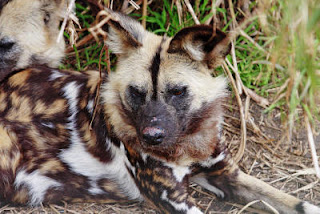There is a mobal global phone that I can buy for $30, that works in South Africa. When I get back in May, I will upgrade to whatever phone catches my fancy.
I'm sorry for the long rant. It wasn't even the fact of the day. I'm going to start a series of facts about the animals I might get to see in Kruger National Park while on safari. Since I began this blog with a slightly bitter cell phone rant, I am going to write this fact about African Wild Dogs, because I like them so much!
The African Wild Dog (Lycaon pictus) is one of Africa's most endangered species, with the main reason for its decline being human persecution. Its name derives from the Greek word for "wolf" and the Latin word for "painted". It is the largest African candid, and the second largest canid in general (behind the gray wolf, my other favorite canid). Its preferred habitats are scrub savannahs and lightly wooded areas.
Like wolves, wild dogs hunt and live in packs. Females leave their birth pack at 14-30 months of age to join packs that lack mature females. Males, on the other hand, tend to stay in the pack they were born into. These packs are separated into male and female hierarchies. In the female hierarchy, the oldest will have alpha (boss) status over the others, whereas in the male structure the oldest (father) as well as the most dominant brother will be dominant. will. Again like wolves, only the dominant female is usually able to rear pups. Unlike wolves, submission and nonaggression are emphasized heavily, and dominance is established without bloodshed. a When there are puppies about, some adult members of the pack will stay behind to watch them while the rest of the group hunts.
The wild dog is a cursorial hunter, meaning that in pursues its prey in long, open chase. Almost 80% of all wild dog hunts end in a kill, which is really high. The lion, which is viewed as a top predator, only ends about 30% of her hunts with a kill. Members of the pack coordinate their movements using a chirping, squeaky sound. They also use the position of their rather large ears to communicate to one another.
After a kill, the hunters will regurgitate meat for those left behind during the hunt, including the pups and their puppysitters. Wild dogs typically hunt medium-to-large sized ungulates such as the impala, the Thompson's Gazelle, Springbok, kudu, reedbuck, and wildebeest calves. Some of the larger packs are able to take down larger animals such as zebras and warthogs. Interestingly enough, studies indicate that the tactics used to take down the larger animals may be a learned behavior, passed down from generation to generation within specific hunting packs.Besides communication, their ridiculously large (and by large I mean adorable) ears also keep the wild dog cool by radiating body heat. Its unique coat pattern serves as disruptive coloration the makes the animal look much larger than it really is. The coloring also confuses the prey, making the animal blend in with the shadows that are around when they like to hunt, which is around dawn and dusk.
 |
| Look at those ears! |
 |
| Can you see why that pelt would be confusing? |
Did you know that Anatolian Shepherds are used as a non-lethal method to protect livestock from cheetah predation? I'll let Cathryn Hilker from the Cincinnati Zoo tell you all about it! Please pay careful attention at around 3:30. It is too cute for words.



No comments:
Post a Comment